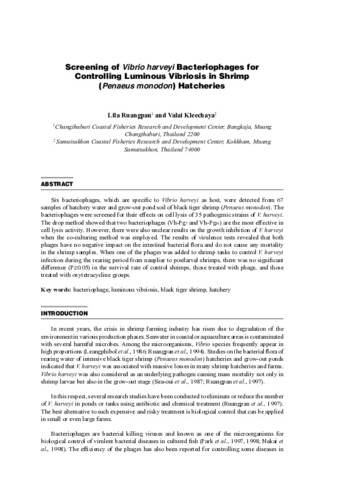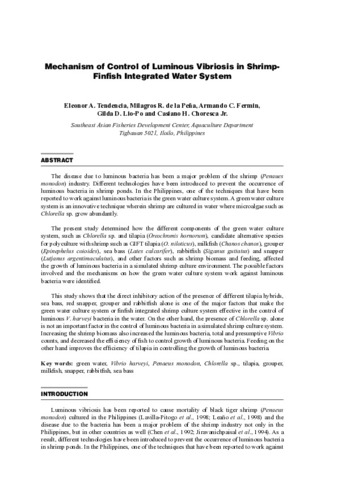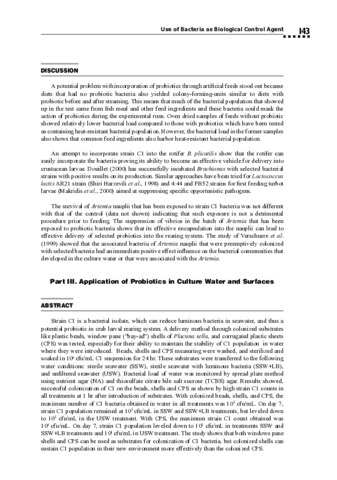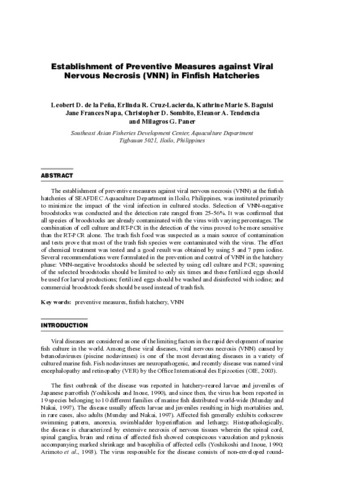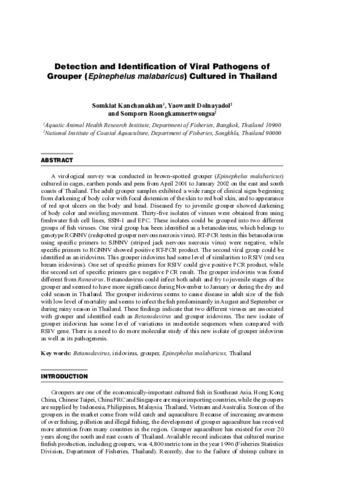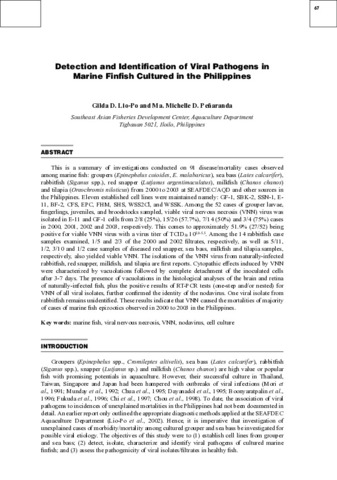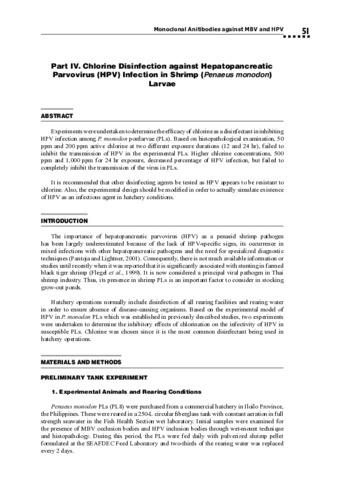Recent Advances in Diagnosis and Prevention of Fish and Shrimp Diseases in Southeast Asia: Recent submissions
Now showing items 21-40 of 43
-
Screening of Vibrio harveyi bacteriophages for controlling luminous vibriosis in shrimp (Penaeus monodon) hatcheries
(Aquaculture Department, Southeast Asian Fisheries Development Center, 2005-03)Six bacteriophages, which are specific to Vibrio harveyi as host, were detected from 67 samples of hatchery water and grow-out pond soil of black tiger shrimp (Penaeus monodon). The bacteriophages were screened for their ... -
Mechanism of control of luminous vibriosis in shrimp-finfish integrated water system
(Aquaculture Department, Southeast Asian Fisheries Development Center, 2005-03)The disease due to luminous bacteria has been a major problem of the shrimp (Penaues monodon) industry. Different technologies have been introduced to prevent the occurrence of luminous bacteria in shrimp ponds. In the ... -
Antibacterial metabolites in the microbial and phytoplankton flora of the "green water" culture of shrimp (Penaeus monodon): Part III. Biocontrol of luminous Vibrio in the grow-out culture of shrimp (Penaeus monodon)
(Aquaculture Department, Southeast Asian Fisheries Development Center, 2005-03)The development of an “indigenous probiotic” for the grow-out culture of black tiger shrimp (Penaeus monodon) was pursued in this study. Five of nine bacterial isolates with demonstrated anti-luminous Vibrio metabolites ... -
Antibacterial metabolites in the microbial and phytoplankton flora of the "green water" culture of shrimp (Penaeus monodon): Part II. Fish mucus and luminous Vibrio
(Aquaculture Department, Southeast Asian Fisheries Development Center, 2005-03)Experiments on the presence of anti-luminous Vibrio properties in marine fish species cultured in the Philippines, i.e., jewel tilapia (Oreochromis hornorum), red tilapia (hybrid of Oreochromis niloticus and O. mossambicus), ... -
Antibacterial metabolites in the microbial and phytoplankton flora of the "green water" culture of shrimp (Penaeus monodon): Part I. Anti-luminous vibrio factors associated with the "green water" grow-out culture of shrimp (Penaeus monodon)
(Aquaculture Department, Southeast Asian Fisheries Development Center, 2005-03)The ability of the “green water” grow-out culture of black tiger shrimp (Penaeus monodon) to prevent outbreaks of luminous vibriosis was investigated by screening associated isolates of bacteria, fungi, phytoplankton and ... -
Experimental evaluation of probiotics as biocontrol/bioremediation in the rearing of shrimp (Penaeus monodon)
(Aquaculture Department, Southeast Asian Fisheries Development Center, 2005-03)Two hundred fifty-liter (250-L) fiberglass tanks each equipped with 15-L capacity filter tanks are adequate for screening of commercial probiotics. The application of some commercial probiotics in the culture water is more ... -
Use of bacteria as biological control agent against microbial diseases in shrimp (Penaeus monodon) and crab (Scylla serrata) hatcheries: Part III. Application of probiotics in culture water and surfaces
(Aquaculture Department, Southeast Asian Fisheries Development Center, 2005-03)Strain C1 is a bacterial isolate, which can reduce luminous bacteria in seawater, and thus a potential probiotic in crab larval rearing system. A delivery method through colonized substrates like plastic beads, window pane ... -
Use of bacteria as biological control agent against microbial diseases in shrimp (Penaeus monodon) and crab (Scylla serrata) hatcheries: Part II. Application of probiotics in natural food and artificial feeds
(Aquaculture Department, Southeast Asian Fisheries Development Center, 2005-03)The suitability of probiotic bacterial incorporation into artificial diets was tested with inferior results due to the interference of heat-resistant starins that are associated with several feed ingredients. However, ... -
Use of bacteria as biological control agent against microbial diseases in shrimp (Penaeus monodon) and crab (Scylla serrata) hatcheries: Part I. Isolation and selection of bacteria for biological control in crustacean hatcheries
(Aquaculture Department, Southeast Asian Fisheries Development Center, 2005-03)A study aimed at obtaining a biological control agent against bacterial diseases of hatchery-reared shrimps and crabs was conducted. Bacteria were isolated from crustacean rearing environments where luminescent vibriosis ... -
Establishment of preventive measures against viral nervous necrosis (VNN) in finfish hatcheries
(Aquaculture Department, Southeast Asian Fisheries Development Center, 2005-03)The establishment of preventive measures against viral nervous necrosis (VNN) at the finfish hatcheries of SEAFDEC Aquaculture Department in Iloilo, Philippines, was instituted primarily to minimize the impact of the viral ... -
Prevalence of economically-important viral diseases in wild shrimp (Penaeus monodon) in the Philippines
(Aquaculture Department, Southeast Asian Fisheries Development Center, 2005-03)Prevalences of white spot syndrome virus (WSSV) and monodon baculovirus (MBV) were determined using polymerase chain reaction (PCR) as the detection method in wild black tiger shrimp (Penaeus monodon) collected from seven ... -
Detection and identification of iridoviral pathogens of freshwater fish in Thailand
(Aquaculture Department, Southeast Asian Fisheries Development Center, 2005-03)An iridovirus or ranavirus survey was conducted in Thailand during April 2003 to March 2004. Five hundred and sixty-six diseased plus healthy fish and frog specimens were examined for the possibility of ranavirus infection ... -
Detection and identification of viral pathogens of grouper (Epinephelus malabaricus) cultured in Thailand
(Aquaculture Department, Southeast Asian Fisheries Development Center, 2005-03)A virological survey was conducted in brown-spotted grouper (Epinephelus malabaricus) cultured in cages, earthen ponds and pens from April 2001 to January 2002 on the east and south coasts of Thailand. The adult grouper ... -
Detection and identification of viral pathogens in marine finfish cultured in the Philippines
(Aquaculture Department, Southeast Asian Fisheries Development Center, 2005-03)This is a summary of investigations conducted on 91 disease/mortality cases observed among marine fish: groupers (Epinephelus coioides, E. malabaricus), sea bass (Lates calcarifer), rabbitfish (Siganus spp.), red snapper ... -
Development of shrimp (Penaeus monodon) cell culture in vitro
(Aquaculture Department, Southeast Asian Fisheries Development Center, 2005-03)Primary shrimp cell cultures were successfully developed from lymphoid organ of black tiger shrimp (Penaeus monodon) in double-strength Leibovitz’s L-15 medium supplemented with 15% fetal bovine serum, 1% glucose, 15% ... -
Chlorine disinfection against hepatopancreatic parvovirus (HPV) infection in shrimp (Penaeus monodon) larvae
(Aquaculture Department, Southeast Asian Fisheries Development Center, 2005-03)Experiments were undertaken to determine the efficacy of chlorine as a disinfectant in inhibiting HPV infection among P. monodon postlarvae (PLs). Based on histopathological examination, 50 ppm and 200 ppm active chlorine ... -
Production of polyclonal antibodies (PAbs) against monodon baculovirus (MBV) and hepatopancreatic parvovirus (HPV)
(Aquaculture Department, Southeast Asian Fisheries Development Center, 2005-03)Monodon baculovirus (MBV) and hepatopancreatic parvovirus (HPV) are two of the viral pathogens, which infect penaeid shrimps in the Philippines. Polyclonal antibodies (PAbs) to MBV and HPV were raised by immunization of ... -
Development of monoclonal antibody (MAb) against monodon baculovirus (MBV) and hepatopancreatic parvovirus (HPV)
(Aquaculture Department, Southeast Asian Fisheries Development Center, 2005-03)Antibody-based detection methods are relatively simple and rapid, aside from being specific and sensitive. Thus, there is a necessity to develop such techniques for early and rapid diagnosis of viral pathogens such as MBV ... -
Studies on the experimental transmission model of monodon baculovirus (MBV) and hepatopancreatic parvovirus (HPV) in shrimp (Penaeus monodon)
(Aquaculture Department, Southeast Asian Fisheries Development Center, 2005-03)Series of experiments on the transmission of monodon baculovirus (MBV) and hepatopancreatic parvovirus (HPV) in Penaeus monodon were undertaken. Feeding of MBV-infected carcasses to experimental shrimps resulted to 100% ... -
Standardization of diagnostic methods for monodon baculovirus (MBV) and hepatopancreatic parvovirus (HPV): Establishment of monoclonal antibodies (MAbs) against MBV and HPV
(Aquaculture Department, Southeast Asian Fisheries Development Center, 2005-03)Monodon baculovirus (MBV) and hepatopancreatic parvovirus (HPV) remain as two of the serious pathogens that infect black tiger shrimp (Penaeus monodon) in the Philippines. It is, therefore, necessary to prevent the spread ...

